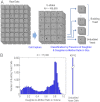High-throughput single-microparticle imaging flow analyzer
- PMID: 22753513
- PMCID: PMC3406874
- DOI: 10.1073/pnas.1204718109
High-throughput single-microparticle imaging flow analyzer
Abstract
Optical microscopy is one of the most widely used diagnostic methods in scientific, industrial, and biomedical applications. However, while useful for detailed examination of a small number (< 10,000) of microscopic entities, conventional optical microscopy is incapable of statistically relevant screening of large populations (> 100,000,000) with high precision due to its low throughput and limited digital memory size. We present an automated flow-through single-particle optical microscope that overcomes this limitation by performing sensitive blur-free image acquisition and nonstop real-time image-recording and classification of microparticles during high-speed flow. This is made possible by integrating ultrafast optical imaging technology, self-focusing microfluidic technology, optoelectronic communication technology, and information technology. To show the system's utility, we demonstrate high-throughput image-based screening of budding yeast and rare breast cancer cells in blood with an unprecedented throughput of 100,000 particles/s and a record false positive rate of one in a million.
Conflict of interest statement
The authors declare no conflict of interest.
Figures




References
-
- Mertz JC. Introduction to Optical Microscopy. Greenwood Village, CO: Roberts and Company Publishers; 2009.
-
- Pawley J. Handbook of Biological Confocal Microscopy. New York: Springer; 2006.
-
- Drapcho C, Nghiem J, Walker T. Biofuels Engineering Process Technology. New York: McGraw-Hill Professional; 2008.
-
- Wollman R, Stuurman N. High throughput microscopy: From raw images to discoveries. J Cell Sci. 2007;120:3715–3722. - PubMed
-
- Tse HTK, Meng P, Gossett DR, Irturk A, Kastner R, Di Carlo D. Strategies for implementing hardware-assisted high-throughput cellular image analysis. J Lab Autom. 2011;16:422–430. - PubMed
Publication types
MeSH terms
Grants and funding
LinkOut - more resources
Full Text Sources
Other Literature Sources
Medical
Molecular Biology Databases

